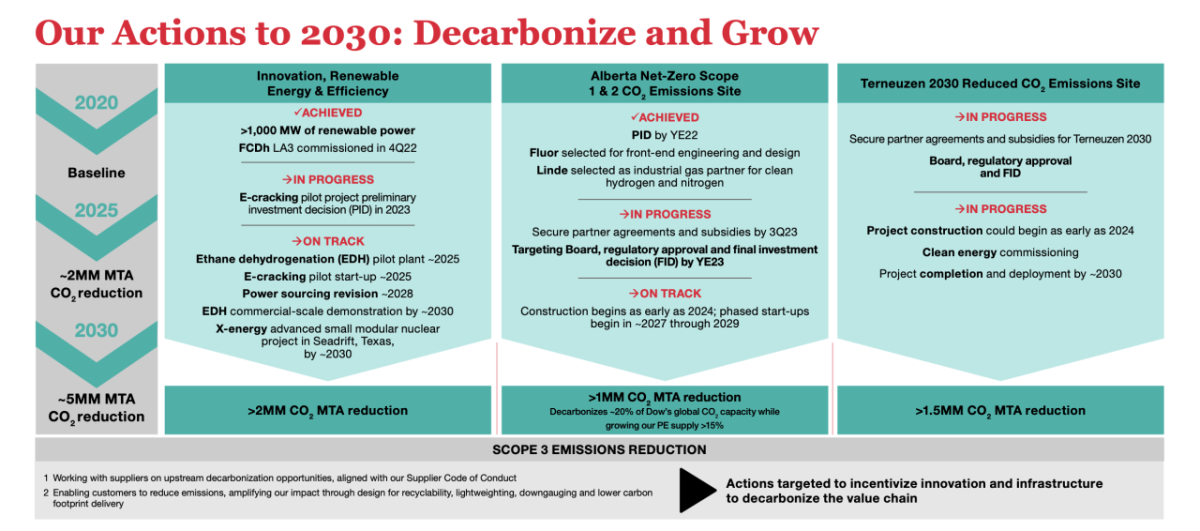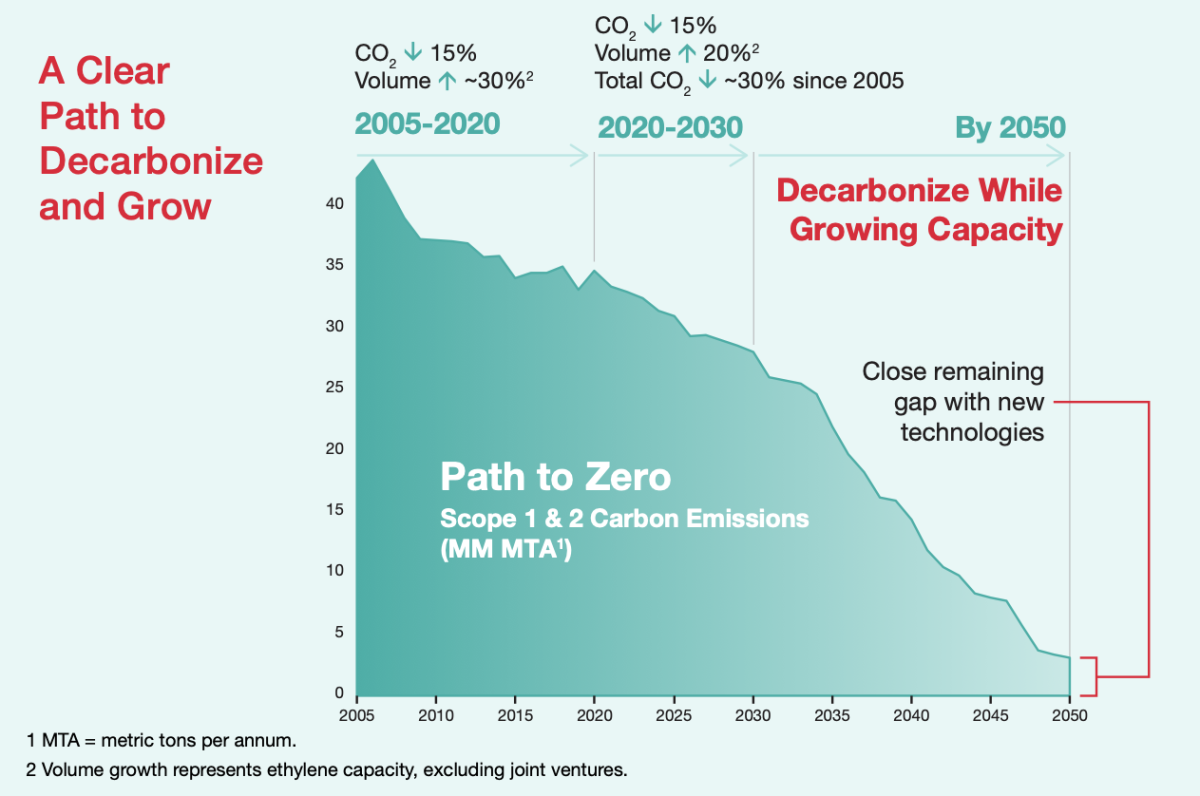Investing in Decarbonization Across Dow
Originally published in Dow's 2022 INtersections Progress Report
We intend to invest approximately $1 billion annually across the economic cycle to drive both growth and decarbonization of our manufacturing assets, which is well in line with the capital outlay that we want to maintain around depreciation and amortization levels through the economic cycle. We have a detailed investment plan and roadmap to our 2050 carbon-neutrality target that touches nearly every aspect of our business, focusing on the following five key areas.
OUR ACTIONS
- Optimizing Our Manufacturing Facilities and Processes for Sustainability
- Increasing Use of Clean Energy and Steam
- Investing in Transformative, Next-Generation Manufacturing Technology
- Developing Low-Carbon Products and Services
- Building a Value-Generating Scope 3 Decarbonization Pathway
Our carbon reduction strategy includes all three carbon emissions scopes.
SCOPE 1
Emissions directly under our control from our own operations
SCOPE 2
Emissions caused indirectly from the generation of power and steam we purchase from third parties
SCOPE 3
Emissions we are indirectly responsible for – upstream from the products or services we buy from suppliers, and downstream from the transportation, usage and end of life of our sold products
COLLABORATING ON DEVELOPING SECTOR DECARBONIZATION TARGETS
Our decarbonization goals and targets are grounded and based on more than 125 years of science, technical expertise and decades of sustainability leadership. Our targets are aligned with the widely recognized IEA Net Zero Emission by 2050 Scenario (NZE), which accounts for realities of industrial sectors.
The Science-based Target initiative (SBTi) is currently developing a chemical sector-specific decarbonization guideline that we expect will reflect the technical challenges and realities of the chemical sector and that likely will consider the NZE model. Dow is a member of SBTi’s expert advisory group providing input for development of this guideline, which is expected to be complete in early 2024. We recognize the importance of collaboration in addressing climate change and are committed to working toward a standard that is effective in reducing emissions and relevant for our sector.
2022 Actions to Support Our Decarbonize and Grow Strategy
OPTIMIZING OUR MANUFACTURING FACILITIES AND PROCESSES FOR SUSTAINABILITY
We are taking a phased, site-by-site approach to reducing our carbon footprint. In 2022, we outlined detailed roadmaps for each of our 25 highest carbon- emitting sites. These plans include replacing end-of-life and high-carbon-intensity assets with more carbon-efficient technologies, and investing in carbon- abatement technologies, including circular hydrogen and carbon capture and storage.
2022 Actions
- Our Board of Directors approved the preliminary investment decision to proceed with the world’s first net-zero carbon emissions integrated ethylene cracker and derivatives site in Fort Saskatchewan, which will triple the site’s capacity, while retrofitting existing assets to be net zero. This will decarbonize approximately 20% of Dow’s global ethylene capacity. We also awarded Fluor with the contract for front-end engineering and design services and selected Linde as the industrial gas partner to supply clean hydrogen and nitrogen for the project.
- Our Terneuzen 2030 project, where we have a clear road map to reduce carbon emissions at the site by more than 40% by 2030, is progressing as we secure partner and government agreements and subsidies.
- Our team developed and approved Scope 1 and 2 carbon emissions reduction plans for Dow’s 25 highest emitting sites – which collectively account for approximately 95% of those emissions – in 2022 and are working to further define project opportunities in 2023.
INCREASING USE OF CLEAN ENERGY AND STEAM
Dow is among the top 20 global corporations for renewable power purchases.
2022 Actions
- In 2015, Dow set a target to contract 750 MW of renewable power capacity by 2025, a target we have achieved. In 2022, we expanded our access to renewable power capacity to more than 1,000 megawatts (MW), enabling approximately 40% of our purchased electricity to come from renewable sources. Though we expect variation in this amount year over year, we expect achievement of our target to be maintained.
- We announced a collaboration with X-energy with the intent to utilize zero-carbon-emissions advanced nuclear technology at our UCC1 Seadrift, Texas, site by the end of the decade.
- 1 Union Carbide Corporation is a wholly owned subsidiary of The Dow Chemical Company.
INVESTING IN TRANSFORMATIVE, NEXT- GENERATION SOLUTIONS FOR CLIMATE PROTECTION
We’re investing in manufacturing technology innovations, such as fluidized catalytic dehydrogenation (FCDh), ethane dehydrogenation (EDH) and electric cracking technology (e-cracking), that will help us transition to cleaner manufacturing facilities by 2050.
2022 Actions
- We mechanically completed and began final commissioning of our FCDh unit in Louisiana. This breakthrough propylene technology features up to 25% lower capital outlay while reducing energy usage and greenhouse gas (GHG) emissions by up to 20% versus conventional propane dehydrogenation units.
- We continue to advance our collaborative e-cracking technology program with Shell, which is on track to start up in 2025. In 2022, we started up an experimental unit at the Energy Transition Campus Amsterdam, the Netherlands. This represents a key milestone in the companies’ joint technology program to electrify steam cracking furnaces, bringing the companies one step closer to decarbonizing one of the most carbon-intensive aspects of petrochemical manufacturing.
- We also continue to advance EDH technology, which is expected to deliver 20% lower capital intensity and 40% lower carbon emissions than any cracker in Dow’s fleet today.
DEVELOPING LOW-CARBON PRODUCTS, TECHNOLOGIES AND SERVICES
We’re helping our customers achieve their climate goals by providing products that facilitate energy efficiency, lightweighting, fuel transition, circularity, increased operational efficiency, resource reductions and reduced emissions.
2022 Actions
- Plastics enable innovations in approximately 30% of the global economy, including construction, health care, transportation and food safety, and can play an important role in reducing GHG emissions. Studies have found that in applications where non-plastic alternatives are available, the alternatives typically emit two times the GHGs compared to plastics.
- For the construction industry, we launched the Dow Carbon-Neutral Silicone Service for Building Façades used in structural glazing, insulating glass and weathersealing applications available for global specification in high- performance building projects.
- For lower-carbon mobility, we commercialized VORATRONTM MA 8200S high-bonding adhesives, which are designed to enhance the safety, durability, sustainability, integrated assembly and overall performance of electric vehicle battery packs. The adhesives contain bio-based components, contribute to reduced vehicle weight, and make it easier to dismantle and recycle battery packs. Additional actions and details can be found in GRI 3-3 Management approach – Energy and Emissions Management.
BUILDING A VALUE-GENERATING SCOPE 3 DECARBONIZATION PATHWAY
Approximately 70% of Dow’s emissions footprint falls into the Scope 3 categories – and more than half of those come from the raw materials, transportation and other services we purchase as a company. We recognize the significant opportunity we have to work with our suppliers to reduce those emissions – just as our customers are looking to us to reduce emissions for the products they buy from us.
2022 Actions
We’re working closely with our suppliers to set emissions reduction targets and embed sustainability, inclusion and diversity performance as a metric in supplier selection, contracting and relationship management. In 2022, Dow was recognized as a Global Supplier Engagement Leader by CDP, a global nonprofit that helps companies disclose their environmental impacts. Dow scored among the top 8% of companies that disclosed data to CDP and achieved an “A” score on their Supplier Engagement Rating System.
We achieved notable advancements in our Scope 3 strategy through three pillars:
- Improving data. We are investing time and effort to more accurately account for our Scope 3 emissions. In 2022, we continued to leverage our wealth of internal data, looking at invoices, sales and shipment data, and included supplier carbon-intensity data for the first time to get a more complete and reliable picture of our Scope 3 emissions. Further, we streamlined our calculation process to enable more robust validation and the allocation of Scope 3 emissions by business and region.
- Enabling transparency. We continue to build transparency across our supply chain by encouraging all of our suppliers to share data on their carbon emissions and climate strategy publicly. In 2022, we grew our participation in the CDP Supply Chain program by inviting suppliers representing more than 80% of our upstream emissions to disclose their emissions to Dow directly.
- This engagement enabled us to significantly expand our use of value chain data in Scope 3 accounting and include supplier product carbon footprints in our reporting of upstream categories for the first time, as well as achieve 100% primary data from our joint ventures.
- We are actively collaborating with initiatives such as the World Business Council for Sustainable Development Partnership for Carbon Transparency, Together for Sustainability and the Global Logistics Emissions Council.
Progressing toward Dow’s 2050 carbon-neutrality goal.
We created an internal Scope 3 dashboard that puts Scope 3 data in the hands of Dow’s businesses and functions, enabling the development of data-driven Scope 3 improvement planning.
- Our advancements in carbon accounting have helped us more accurately uncover opportunities to reduce Scope 3 emissions to deliver on our 2050 carbon-neutrality goal.
- Our procurement, supply chain, product design, circular economy and commercial strategy teams are all participating in Scope 3 reduction plans. Further, we are working to educate our employees on how they can help reduce Scope 3 emissions by minimizing waste and choosing lower-carbon transportation. Additional actions and details can be found in GRI 3-3 Management approach – Sustainable Procurement



